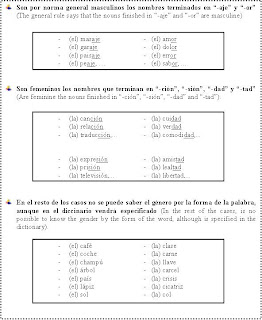- En Español todos los sustantivos (nombres) tienen siempre género, masculino o femenino, no existen los neutros (In Spanish, all the nouns have always gender, masculine or feminine, there are no neutrals).
- Es muy importante saber si un sustantivo (nombre) es masculino o femenino, por que todos los elementos que se refieren a él (artículos, adjetivos, demostrativos, ...) deben tener el mismo género (Is very important to know if a noun is masculine or feminine, because all the elements which are referred to it (articles, adjectives, demonstratives, ...) have to have the same gender).

- Sin embargo, no siempre se siguen las reglas generales para la formación del género. En Español encontramos numerosas excepciones (However, not always the general rules are followed to form the gender. In Spanish we find many exceptions)
FUERA DE LA REGLA DE LA "-A" Y LA "-O"
(Out of the "-A" and the "-O" Rule)



No hay comentarios:
Publicar un comentario